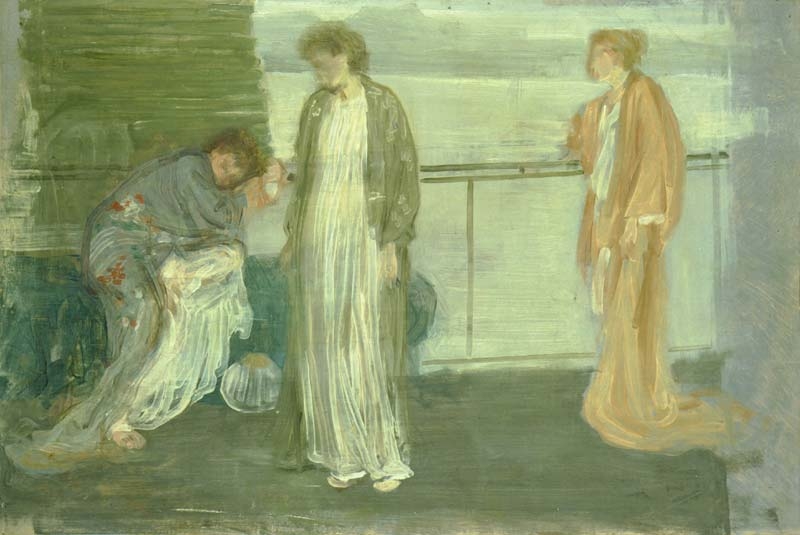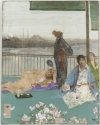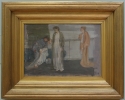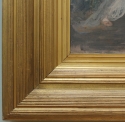Composition
A drawing, r.: A group of figures; v.: Figure [M.0341] may have been a preliminary study for this painting, or a related composition.
The oil Study of Draped Figures is related to the so-called 'Six Projects', particularly Variations in Blue and Green [YMSM 084], and to another figure composition, Variations in Flesh Colour and Green: The Balcony [YMSM 056] and Sketch for 'The Balcony' [YMSM 057].
There are a number of obvious points of comparison between three of these (Variations in Flesh Colour and Green: The Balcony [YMSM 056], Sketch for 'The Balcony' [YMSM 057] and the painting under discussion, Study of Draped Figures), and two paintings of Whistler's studio (The Artist's Studio [YMSM 062] and Whistler in his Studio [YMSM 063]).
The composition of Variations in Flesh Colour and Green: The Balcony [YMSM 056], with the balcony itself, the dark green blinds, and the view across the river, corresponds in part to the roughly sketched out design of Study of Draped Figures.
In Study of Draped Figures, the balcony, the sofa, and the women at the sides were originally painted nearly 12 mm higher (the woman on the right was leaning with her right arm on the railing). The line of the railings and floor can be seen going right through the two women at left. There appears to have been a standing figure or another seated figure at far left, on the bench. The draperies over the sofa originally extended further right, and a round object, possibly a vase, stood in the centre of the floor.
The pale pink or peach-coloured kimono of the model at right in the Study of Draped Figures appears on the central model in The Artist's Studio [YMSM 062] and Whistler in his Studio [YMSM 063]: Whistler referred to the latter model as 'la Japonaise'. 1 She may also be the woman lying down in Variations in Flesh Colour and Green: The Balcony [YMSM 056]. However her features are so generalised that it is not possible to be sure of this.
Similarly, the blue robe, embroidered with red and white flowers, is seen on the musician in The Balcony and the seated woman in Study of Draped Figures.
Finally, the sofa in the Study of Draped Figures appears to have had a high rounded back on the left, just like the white couch in The Artist's Studio [YMSM 062] and Whistler in his Studio [YMSM 063].
Technique
Study of Draped Figures is painted on a tabby linen canvas with white commercial priming. There is a pinkish-mushroom imprimatura. 2
The two figures at left were painted with a brush 6.4 mm (¼" wide), using a megilp-type medium that has become more transparent. The woman on the right appears to have been added later than the others; she was painted with a larger brush, and the grey floor and water were painted up to her. The thin paint is built up with delicate brush-strokes, capturing the changing light on flesh and shimmering robes. It is not clear what happened at the far left and right, which basically look scraped down and unfinished.
This canvas was neatly trimmed with scissors and is some 5 mm smaller on all sides than the lining canvas. It was lined onto a pale straw-coloured, fine plain-weave canvas lapping some 15 mm onto the reverse of the stretcher and likely glued down. It is lined onto cream-coloured tape on the tacking margins. At the back, this tape is overlain by grey/brown tape and later by brown tape. Both tapes overlie a partial label for Gladwell Brothers in Gracechurch Street, London, who were in business 1880-1892 at that address. The cream tape has numerous tacks fixing it to the stretcher margins, placed with equal spacing roughly 3 cm apart. Hence there was a lining and taping treatment, likely in 1880-1892, carried out in order for Whistler to rework it. 3
At a point on each of the lower and left edges, the paint runs onto a gap in the tape, and onto the tape, respectively. Thus, it would appear that Whistler reworked it after it was lined and restretched.
Conservation History
The paint is rubbed badly at the edges, and has been scraped off down the right side. It seems possible, from its dilapidation, that it was one of the canvases partially destroyed by Whistler at the time of his bankruptcy in 1879.
The canvas was lined with a tabby linen, probably in Whistler's time, as discussed above. Professor Townsend adds:
'There are pinholes within the sight area, and within 10 mm of the cut edges, along the top and bottom edges. At the sides, there are even more pinholes, irregularly spaced and up to 20 mm into the sight area. All the pins went through some existing priming and almost certainly existing paint too. None is covered over with paint from the reworking.' 4
There are a few old paint losses and scratches, and craquelure at left, but it is basically in good condition. 5
Frame
It is in a Grau-style frame. There is a partial 'City of London' label on the back, as well as a label bearing the name and address of Rosalind Birnie Philip (1873-1958) .
Notes:
1: Whistler to H. Fantin-Latour, 16 August [1865], GUW #01147.
2: Condition report by Clare Meredith, 8 May 2001, Hunterian files. Profesor Joyce H. Townsend, Tate Britain, report on examination of the canvas, July 2017.
3: Townsend, 2017, op. cit.
4: Townsend, 2017, op. cit.
5: Meredith, 8 May 2001, op. cit.
Last updated: 20th October 2020 by Margaret











